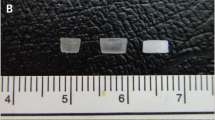Abstract
A synthetic, monofilament, absorbable suture material, polytrimethylene carbonate, was tested to determine its suitability for use in arterial anastomoses. The material studied is a copolymer made of trimethylene carbonate and polyglycolic acid, with a retention time in the tissue of up to six months. In an experimental group of 12 mongrel dogs, using simple end-to-end anastomoses, aortic and femoral patch grafts of bovine heterograft material and iliofemoral bypass implants of 5 mm of expanded polytetrafluoroethylene prostheses were performed and arteriographically and histologically documented. Direct intraindividual comparisons were made with the absorbable (polytrimethylene carbonate) and nonabsorbable (polypropylene, expanded polytetrafluoroethylene suture) materials, a total of 108 anastomoses. No suture material-related complications such as ruptures or suture line aneurysms occurred. Polytrimethylene carbonate sutures led to less inflammation and scar tissue formation than polypropylene sutures. Complete absorption of the suture material by hydrolytic decomposition was followed by an almost complete regeneration in all layers of the vessel wall. Regeneration of the connective tissue structures of the media was noted. Initial associated reactions in the intima eventually disappeared. Both suture materials were equivalent histologically in the early months of the study, but after 10 month follow-up differences were observed, especially in the structure of the media, apart from the fact that polytrimethylene carbonate is absorbed completely after four to seven months.
Similar content being viewed by others
References
CALHOUN TR, KITTEN CM. Polypropylene suture—is it safe?J Vasc Surg 1986;4:98–102.
RODEHEAVER GT, BORZELLCA DC, THACKER JG, et al. Unique performance characteristics of Novafil.Surg Gynecol Obstet 1987;164:230–236.
DETERLING RA, COLEMANN CC, KEE J, et al. An experimental evaluation of catgut as a vascular suture material and a report on its clinical use.J Thorac Surg 1952;23:303–309.
DAHLKE H, DOCIU N, THURAU K. Synthetisches, resorbierbares und synthetisches, nicht resornierbares Nahtmaterial in der mikrovascularen Chirurgie. Tierexperimentelle Studie.Handchirurgie 1979;11:13–21.
DARDIK H, DARDIK I, KATZ AR, et al. A new absorbable synthetic suture in growing and adult primary vascular anastomoses: morphologic study.Surgery 1970;68:1112–1119.
LEE S, FUNG YC, MATSUDA M, et al. The development of mechanical strength of surgically anastomosed arteries sutured with Dexon.J Biomech 1985;18:81–87.
ROSS G, PAVILDES C, LONG F, et al. Absorbable suture material for vascular anastomoses.Am Surg 1981;47:541–548.
SANDMANN W, TORSELLO G, KASCHNER A, et al. Experimentelle ergebnisse und linische erfahrungen mit PGS-faden in der arterienchirurgie. In: THIEDE AU, HAMELMANN H (eds): Moderne Nahtmaterialien u. Nahttechniken in der Chirurgie. Berlin-Heidelberg-New York: Springer, 1982.
PAE WS, WALDHAUSEN JA, PROPHET GA, et al. Primary vascular anastomosis in growing pigs. Comparison of polypropylene and polyglycolic acid sutures.J Thorac Cardiovasc Surg 1981;81:921–990.
BECK C, BLUNCK F, THIEDE A. Förderung der Gefäßwandregeneration durch Verwendung absorbierbarer Nahmaterialien für Mikrogefäßanastomosen. In: THIED A, HAMELMANN H (eds): Moderne Nahtmaterialien in der Chirurgie. Berlin-Heidelberg-New York: Springer, 1982.
DAHLKE H, DOCIU N, THURAU K. Thrombogenicity of different suture materials as revealed by scanning electron microscopy.J Biomed Mater Res 1980;14:251–261.
USSIA G, FELDMANN D, GALETTI M, et al. Histopathological aspects of tissue reactivity to suture material in microsurgical arterial anastomosis.Ital J Surg Sci 1985;15: 287–295.
TORSELLO GB, SANDMANN W, LENZ W, et al. Experimental studies with absorbable and nonabsorbable sutures in infected canine arterial anastomoses.J Vasc Surg 1986;3:135–139.
TUCHMANN A, DINSTL K. Erste Erfahrungen mit einem monofilen resorbierbaren Nahmaterial in der Gafächirurgie.Angio 1983;5:281–286.
VERSCHUERE I, FRANCOIS K, DE ROOSE J, et al. Polydioxanone suture material in growing vascular anastomoses. Experimental study.J Thorac Cardiovasc Surg 1985;90:765–772.
SCHMITZ-RIXEN T, HORSCH S, KLEIN B, et al. Experimentelle Untersuchungen zur Gefäßwandregeneration bei Verwendung eines neuen monofilen, resorbierbaren Nahtmaterials für arterielle Anastomosen.Langenbecks Arch Chir 1984;362:53–59.
HARJOLA PT, ALA-KULJU K, HEIKKINEN L. Polydioxanone in cardiovascular surgery.Thorac Cardiovasc Surgeon 1984;32:100–107.
HOUDART R. Polydioxanone in digestive surgery.Am J Surg 1986;152:268–271.
MALLON WJ, SEABER AV, URBANIAK JR. A comparison of absorbable and nonabsorbable sutures to vascular response in immature arteries.J Reconstr Microsurg 1986;2:87–92.
MYERS JL, WALDHAUSEN JA, PAE WE, et al. Vascular anastomoses in growing vessels: the use of absorbable sutures.Ann Thorac Surg 1982;34:529–536.
KNOOP M, LUNSTEDT B, THIEDE A. Maxon und PDS—Bewertung physikalischer und biologischer Eigenschaften monofiler, absorbierbarer Nahtmaterialien.Langenbecks Arch Chir 1987;371:13–22.
KATZ AR, MUKHER DP, KAGANOV AL, et al. A new synthetic monofilament absorbable suture made from polytrimethylene carbonate.Surg Gynecol Obstet 1985;161:213–219.
KUO T, HUANG T, HOWNG S. The clinical use of synthetic absorbable suture in vascular surgery.J Formosan Med Assoc 1974;73:45–52.
TSCHEILIESSNIGG KH, STADLER H, HOFLER H, et al. Resorbierbares Nahtmaterial im Rahmen der Herzund Gefäßchirurgie?Chirurgie 1983;54:738–745.
STEEN S, ANDERSSON L, LOWENHIELM P, et al. Comparison between absorbable and nonabsorbable monofilament sutures for end-to-end arterial anastomoses in growing pigs.Surgery 1984;95:202–207.
PATEL CB, SYKES PJ, MELVILLE-JONES G. A comparison of polyglycolic acid and polyamide sutures in experimental microvascular anastomoses.J Thorac Cardiovasc Surg 1981;81:921–927.
ERASMI H, HORSCH S, MULLER J, et al. Gefäßersatz kleinkalibriger Arterien—eine neue bovine Kollagenprothese.Langenbecks Arch Chir 1983;360:97–101.
SAUVAGE LR, HARKINS HN. Growth of vascular anastomoses: an experimental study of the influence of suture type and suture method with a note on certain mechanical factors involved.Bull Johns Hopkins Hosp 1952;91:276–280.
TAWES RL, ABERDEEN E, BERRY CL. The growth of an aortic anastomosis: an experimental study in piglets.Surgery 1968;64:1122–1127.
SHARP WV, BELDEN TA, KING PH, et al. Suture resistance to infection.Surgery 1982;91:61–63.
JOHNSON J, KIRBY CK. The relationship of the method of suture to the growth of end-to-end arterial anastomoses.Surgery 1950;27:17–25.
ALVAREZ-CORDERO R, REYES EL, ALCAZAR MG, et al. Evaluation of polyglycolic acid sutures in vascular surgery.J Surg Res 1973;15:35–44.
Author information
Authors and Affiliations
About this article
Cite this article
Schmitz-Rixen, T., Storck, M., Erasmi, H. et al. Vascular anastomoses with absorbable suture material: An experimental study. Annals of Vascular Surgery 5, 257–264 (1991). https://doi.org/10.1007/BF02329383
Issue Date:
DOI: https://doi.org/10.1007/BF02329383




